Inside Torani
Learning Journeys - Shaking up the Status Quo to a New Path
Regaining Momentum (or An Alternative Approach)
Picture this: You have been growing like crazy for a while, but now sales are reaching a plateau. You are not thrilled about the options being considered; they’re the same recycled ideas. Driven by a strong bias towards action, your team is urging a choice – even a mediocre one – with the hope of creating some momentum. But… you know what got you here isn’t going to get you to the next place. You’re looking for different outcomes.
How to regenerate growth? Spark a new mindset for innovation? Or rethink strategies? In growing companies, we often find ourselves in a situation like this. And the pressure to act can put us into a slow decline on the other side of the growth curve. Here’s what we wondered: Is it possible to take action in a very different way?
Go Slow to Go Fast – The Learning Journey
Our executive team at Torani ventured into our first Learning Journey when hitting a plateau after many years of high growth. Since then, individuals and teams across our company have gone on many Learning Journeys of different kinds. They’ve been a breakthrough approach to making big decisions or changes.
Here's the gist of it: A Learning Journey is a formal undertaking to crack open thinking and perspective before taking strategic action. It’s a mapped-out process over a defined length of time. We’ve found that by taking well-planned time up front to learn (that’s the “go slow” part), the ultimate decision and action is exponentially better and faster.
Here’s how we map it out:
1. Chart the Course: Decide on What, Who, Timeline and Learning Options
2. Hit the Road: Go on the journey with a mindset for learning
3. Debrief: Capture learnings in a route and do a big download at the end
4. Act: Upload to strategies and actions
.png)
To bring this to life, we’d love to share with you what we went through on our first Learning Journey, when we needed to rethink how to approach our slowdown in sales growth.

Define What You Want to Learn
Our executive team met to assess our current state, discuss our current paradigm, and determine our desired future state. Instead of quick fixes, we determined that we needed to rethink how to approach our slowdown in sales growth. This led to the realization that we needed to innovate our business model – and the company itself.
Innovation is a huge topic, so we identified four areas to explore (we believe two to four areas to explore is about right):
- Innovation Process – What company/product processes support innovation?
- Innovation Culture – What aspects of a company’s culture inspire innovation?
- Consumer Connection – How do others really get in the shoes of customers and establish a meaningful connection?
- Organization Structure – What organization structure, practices and leadership instill innovation?
Establish a Timeline and Process
|
Basic Process Timeline Month 1: Frame up the Learning Journey and identify lots of resources and ways to learn Months 2 to Final Month: Actively explore and learn! Final Month: Download learnings, determine strategic implications or top actions to consider, and identify next steps to upload into the organization |
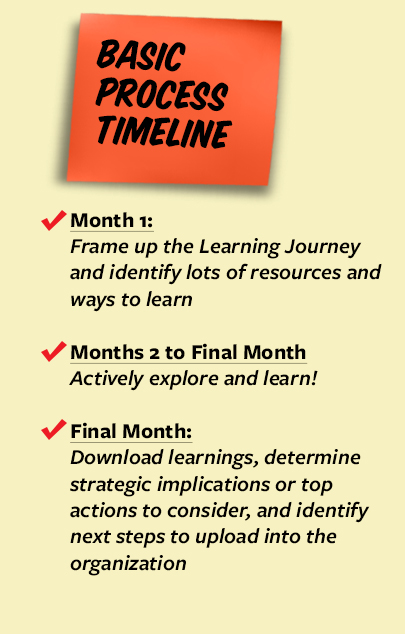 |
Each journey is unique and needs to be sized up for the right amount of time to learn the concept. Did this journey require three months? Six months? A year? We determined our Innovation Learning Journey would take a full year. Yes, a full year! This was going to be a big honking exploration of how we considered our whole business to build a foundation for future growth. And we knew we needed a longer time frame for a true shift in mindset.
We defined who would be on the team. In this case, the team was composed of our executive leaders. Since we had all been involved in the debates over long-term strategies and different options for growth, we decided that we would go on the Learning Journey together so that we’d all be part of the process of identifying – and agreeing upon – our best way forward. Learning as a team was a key part of making certain that wherever our journey took us, and after plenty of interaction and discussion along the way, we would all be together at a new starting point.
Explore Options for Learning and Make Choices
Now that we knew what we wanted to learn about and who would be on the team, our next step was to create a big ol’ list. We identified all the potential books, articles, videos, field trips, and anything else we thought would be worthwhile. We set our goal for a cadence of 1-2 learning activities each month.
When compiling the possibilities, we thought about what would be amazing to add to the list. We thought a field trip to the design company IDEO – and connecting with their lead consumer packaged goods person – would be fantastic, so we added it to the list. We pored through speaker lists from Innovation and Design Thinking conferences and added a few of those folks to the list.
How do you create your list? Think about top source materials, people, and companies that have a connection to your topic, then compare your list to your learning questions. Which books/articles/videos/field trips/guest speakers match up best with what you want to learn? Make a few initial choices. When it comes to field trips and guest speakers, divvy up the list and start making calls. We found that when we explained to people that we were on a Learning Journey, they were surprisingly happy to talk with us. You don’t need everyone to come through, just a few choice gems.
A few helpful things to consider on your journey:
You Can Do This!
The question I’m asked the most is “Did you get an outside facilitator for this?” And the answer is “Nope.” The beauty of a Learning Journey is that you can create it and do it yourself.
We’ve found that, ideally, one person should take the lead role in framing, organizing, and engaging the team on the Journey. For us, I took responsibility for leading the overall Innovation Journey. We then created a core team of three of us to sketch out the timeline, process, and initial list of activity ideas that could help us explore the key questions.
Agree on the principles and mindset for learning
Prepare to Learn
1. Stay in a place of learning, discovery, reflection (vs taking action)
2. Adopt the Mantra of "not knowing"
3. Remind yourself of your learning questions along the way
4. Be Prepared to learn from every angle of the topic
5. Share the load on leadership
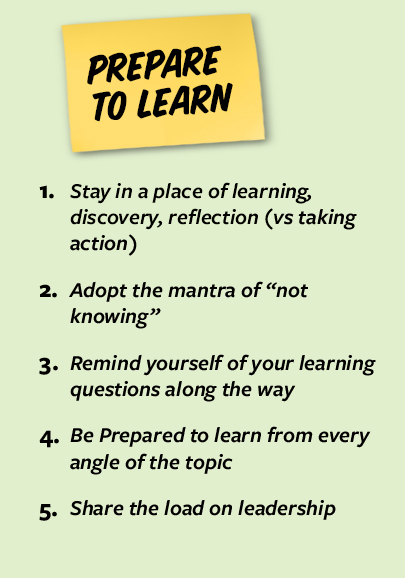
Once the logistical aspects of the Journey are mapped-out, it is worth taking the time to outline and agree to the principles for learning. “Learning mode” can be especially challenging for experienced leaders who’ve likely achieved success by “knowing” what do. We recognized this out loud with our team and talked about how to flex our open-mindedness. We adopted the mantra of not knowing as a virtue – there is no point in going on a Journey if we’re trying to confirm what we already think.
We’ve found a good way to support moving into learning mode is to brainstorm a list of starter questions before going on a field trip. Learning can also be about unlearning, or revealing blind spots, and getting into ‘inquiry mode’ really opened us up to the power of discovery as each of us identified specific areas to probe and understand.
To boost learning and development capacity of the team members, share the load. Take turns at different stages of the Journey. Trade off which team member leads book group discussions, takes the lead on a field trip or with a guest speaker, and writes up the notes and distributes them. With our Innovation Learning Journey, I offered to facilitate our first book group discussion and then opened it up for others to lead the next one. Everyone pitched in to the learning, which helped keep the whole team engaged and sharing their point of view. A singular viewpoint is not helpful!
And, always remember, have fun and make friends along the way.

After each major step in the Journey -- such as after a guest speaker, field trip, or insightful book group discussion -- it is helpful to take a moment to reflect and gather the key learnings. Take turns writing one-page summaries along the way. After weeks and months of learning, we’ve found these to come in handy as pre-reads before the final Learning Journey debrief.
When the Journey ends, it’s time for the Debrief Session. Depending on the Journey, this can be anything from a 2-hour to full-day session. The objective is to gather and distill the key learnings and ideas from the Journey. At this session, your team will revisit the initial questions you set out to explore, solicit lots of input, and select the top insights and learnings to bring forward to the action stage.
Once you have aligned on your key insights and learnings with your Learning Journey team members, it’s time to upload them to the organization. We brought our Innovation Journey insights straight into a 3-year planning session. You might choose to bring them to strategic planning, use them as guidelines for decision-making, or determine other ways to weave these insights into the fabric of your organization. Whether big changes or more subtle ones, in our experience, a Learning Journey always leads to changes in not only our business, but in how we work together as a team.
After the Journey Ends (Or the Next Horizon!)
So what happened when we finished our first Learning Journey? We changed our entire business model! In order to create a new growth curve, we shifted from a café operator-focused model to a consumer-focused one. By shifting our focus to the consumer, it meant that we could simultaneously support both café partner growth as well as overall growth for Torani. And it helped us move into a new era for our business that we call “The Consumer Era.”
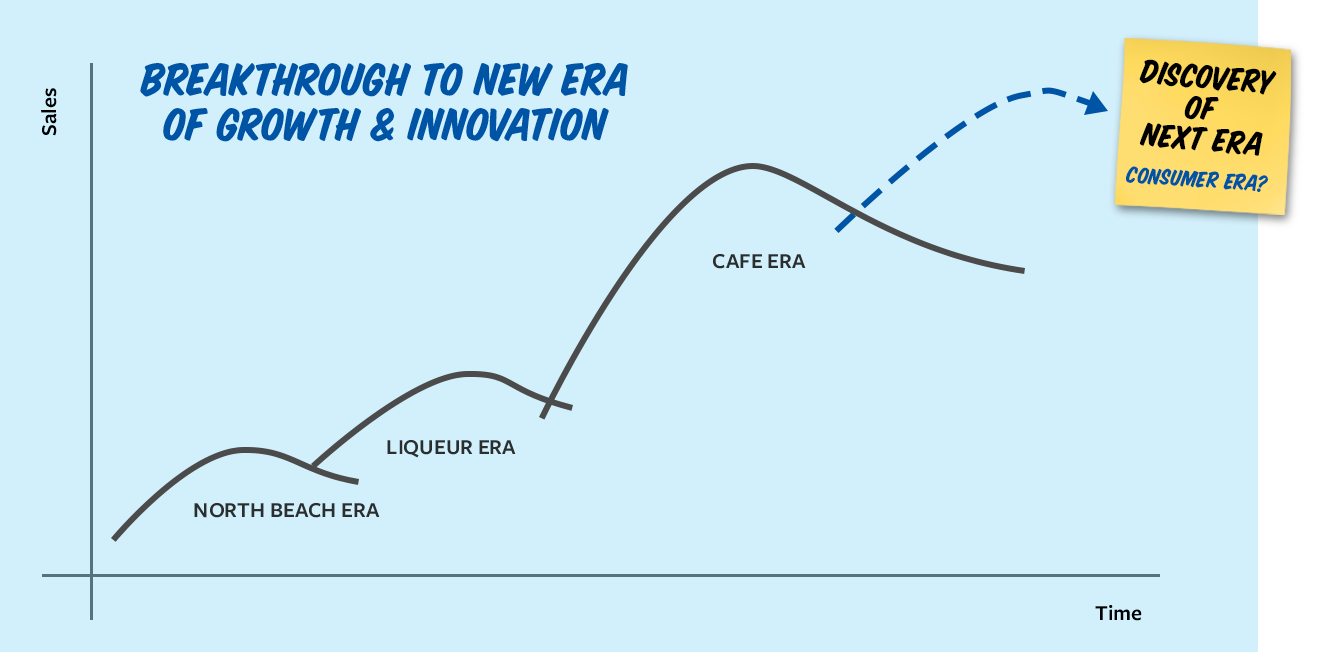
The types of Learning Journeys are as plentiful as companies that are out there. Here is a partial list of learning journeys we've taken:
- Innovation
- New Technology - WMS, PLM
- Org structure of a company 2x-4x our size
- Leadership of a company 2x-4x our size
- How to approach a move, additional site selection
- Supply Chain strategy
- Customer Experience
- JEDI
- and it doesn't stop there...
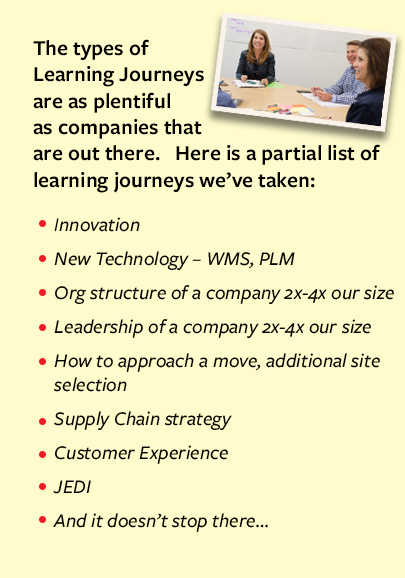
Since this first big and impactful Journey, we’ve gone on many more, with Journeys ranging from a three-month exploration of a potential new technology platform to a six-month Journey on JEDI (Justice, Equity, Diversity, and Inclusion).
The Learning Journey is a formative tool for us. Not only do we learn our way through opportunities and challenges, but we also develop ourselves as individuals, teams, and as a company. We love it and hope this field guide has sparked ideas for you to try too!
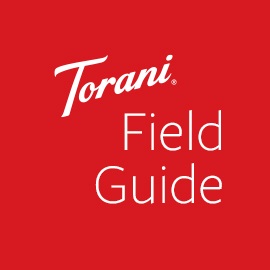 We believe companies flourish when they care deeply for people. Our people practices have helped us to grow by double digits for over 20 years, and we want to explore these practices with you. These field guides are meant to inspire and inform people who share our passion for using business as a force for good in the world. We look forward to your thoughts and ideas on ways we can create more opportunities for people, partners and communities to thrive.
We believe companies flourish when they care deeply for people. Our people practices have helped us to grow by double digits for over 20 years, and we want to explore these practices with you. These field guides are meant to inspire and inform people who share our passion for using business as a force for good in the world. We look forward to your thoughts and ideas on ways we can create more opportunities for people, partners and communities to thrive.




